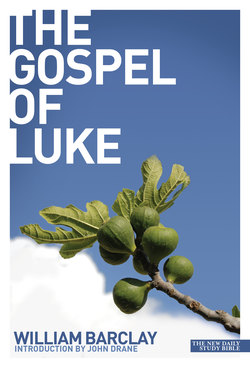Читать книгу Gospel of Luke - William Barclay - Страница 27
На сайте Литреса книга снята с продажи.
ОглавлениеTHE COURIER OF THE KING
Luke 3:1–6
In the fifteenth year of the reign of Tiberius Caesar, when Pontius Pilate was governor of Judaea, and when Herod was tetrarch of Galilee, his brother Philip tetrarch of Ituraea and the district of Trachonitis, and Lysanias tetrarch of Abilene, in the high priesthood of Annas and Caiaphas, the word of God came to John, the son of Zacharias, when he was in the desert. So he came into the territory around Jordan, preaching a baptism of repentance whereby sins might be forgiven – as it stands written in the book of the words of Isaiah, the prophet. ‘The voice of one crying in the wilderness, “Get ready the road of the Lord, make his paths straight; every ravine shall be filled up; every mountain and hill will be made low; the twisted places will be made into straight roads and the rough places into smooth; and all flesh shall see God’s instrument of salvation.” ’
TO Luke the emergence of John the Baptist was one of the hinges on which history turned. So much so is that the case that he dates it in no fewer than six different ways.
(1) Tiberius was the successor of Augustus and therefore the second of the Roman emperors. As early as AD 11 or 12 Augustus had made him his colleague in the imperial power but he did not become sole emperor until AD 14. The fifteenth year of his reign would therefore be AD 28–9. Luke begins by setting the emergence of John against a world background, the background of the Roman Empire.
(2) The next three dates Luke gives are connected with the political organization of Palestine. The title tetrarch literally means governor of a fourth part. In such provinces as Thessaly and Galatia, which were divided into four sections or areas, the governor of each part was known as a tetrarch; but later the word widened its meaning and came to mean the governor of any part. Herod the Great died in 4 BC after a reign of about forty years. He divided his kingdom between three of his sons and in the first instance the Romans approved the decision.
(a) To Herod Antipas were left Galilee and Peraea. He reigned from 4 BC to AD 39 and therefore Jesus’ life was lived in Herod’s reign and very largely in Herod’s dominions in Galilee.
(b) To Herod Philip were left Ituraea and Trachonitis. He reigned from 4 BC to AD 33. Caesarea Philippi was called after him and was actually built by him.
(c) To Archelaus were left Judaea, Samaria and Edom. He was a thoroughly bad king. The Jews in the end actually petitioned Rome for his removal; and Rome, impatient of the continual troubles in Judaea, installed a procurator or governor. That is how the Romans came directly to rule Judaea. At this time Pilate, who was in power from AD 25 until AD 37, was the Roman governor. So in this one sentence Luke gives us a panoramic view of the division of the kingdom which had once belonged to Herod the Great.
(3) Of Lysanias we know practically nothing.
(4) Having dealt with the world situation and the Palestinian political situation, Luke turns to the religious situation and dates John’s emergence as being in the priest-hood of Annas and Caiaphas. There never at any time were two high priests at the one time. What then does Luke mean by giving these two names? The high priest was at one and the same time the civil and the religious head of the community. In the old days the office of high priest had been hereditary and for life. But with the coming of the Romans the office was the object of all kinds of intrigue. The result was that between 37 BC and AD 26 there were no fewer than twenty-eight different high priests. Now Annas was actually high priest from AD 7 until AD 14. He was therefore at this time out of office; but he was succeeded by no fewer than four of his sons and Caiaphas was his son-in-law. Therefore, although Caiaphas was the reigning high priest, Annas was the power behind the throne. That is in fact why Jesus was brought first to him after his arrest (John 18:13) although at that time he was not in office. Luke associates his name with Caiaphas because, although Caiaphas was the actual high priest, Annas was still the most influential priestly figure in the land.
Verses 4–6 are a quotation from Isaiah 40:3–5. When a king proposed to tour a part of his dominions in this region, he sent a courier before him to tell the people to prepare the roads. So John is regarded as the courier of the King. But the preparation on which he insisted was a preparation of heart and of life. ‘The King is coming,’ he said. ‘Mend, not your roads, but your lives.’ There is laid on every one of us the duty to make life fit for the King to see.
